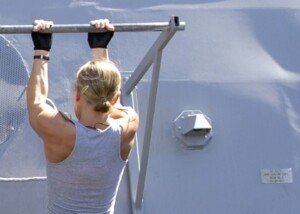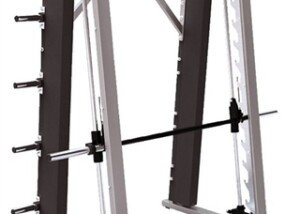
If you can knock off 20 halfway pull-ups, is this really the same as 10 reps from a dead-hang?
Or are you sacrificing muscle recruitment with those cheat reps?
You’ve seen it plenty of times – and maybe you’re guilty of it yourself: Doing a bunch of pull-up reps, but going down only half-way (or three-quarters way) instead of all the way down into a dead-hang before pulling yourself back up (chin to bar).
Now don’t get me wrong. Halfway pull-ups do count — in that they work several muscle groups.
Most people, randomly chosen off the street, would not be able to perform five of these half-reps in a row.
But I’ve always wondered why some people will concentrate on working up to many reps with this move, instead of recalibrating to fewer repetitions from a dead-hang (arms straight).
It Depends on Your Goals
Is it to tone the arms? The half approach will contribute, along with other lifting moves, to toning.
But gee, you may as well sit on a seat and just do palms-forward pull-downs with a narrower-grip handle.
This makes me wonder, then, what the goal really is in those who do incomplete reps.
What I typically see, when someone does half pull-ups, is a NON-overweight man, often middle age, who does many reps in this fashion.
And I think, “Cut the reps in half or a third and you’ll be able to do something closer to a complete range of motion for reach of those reps.”
Let’s admit it: Sometimes, the goal is just to look strong to other gym members. The pull-up is a move that very few people – relative to the general population – can actually do. It’s a classic show move.
Though a popular question is, “How much can you bench?” a popular request is, “Let’s see you do pull-ups.”
Some people get it in their heads that it looks impressive to do high reps of half-pulls.
To them, the number of reps is more important than the quality of the move.
Benefits of Dead-Hang Pull-Ups
If you want to impress others, the dead-hang is the way to go. You know this, because they’re way too hard for you to do for five reps if you’ve only been going halfway!
A complete range of motion also means more back muscle recruitment, and a nice bonus: more abdominal recruitment.
The complete range of motion will engage your “six-pack” muscles in a way that’s totally unique.
Complete range of motion also means getting your chin over the bar.
And yet another benefit to a complete range of motion – from the top of the movement to the bottom – is that it might save you in a real-life crisis. You just never know.
Another benefit to consider is that the full ROM engages the entire biceps group.
The Partial Pull-up Is Done By Both Men and Women
Incomplete repetitions will give you a false sense of accomplishment, but again, if all you want is more tone in your arms, then you’re all set (though it’d be a lot easier to achieve this tone by doing seated, middle-grip lat pull-downs).
Something tells me, however, that the men who do high reps of incomplete pull-ups aren’t gunning for more arm tone.
You might be thinking that repeatedly going down and up, down and up halfway is the only way to develop the strength for full range of motion. But actually, this is not true.
But going only halfway does allow you to do more repetitions – which creates the illusion that you’re stronger than you actually are for this type of movement.
How to Break the Partial Pull-Up Habit
- Grab the bar and dead hang all your weight, legs straight and still.
- Count two seconds.
- Pull yourself up without any yanking, without kicking or lifting your legs.
- If you barely got your chin to the bar, and know you cannot do another one without rest, then that’s perfectly fine. Your starting point is one repetition.
- Rest, then complete another full range rep.
- Rest, then repeat the cycle several more times.
- Do this twice a week. Within 30 days you should be able to complete three, full range reps in a row.
And by the way, the dead-hang in between reps does NOT mean a cheat rest.
Hanging is work. This is why very few people, randomly plucked off the street, can dead-hang for 20 seconds!
People who hang two seconds before each repetition are actually creating more workload – which is good.
Hanging is a form of static weightlifting; you are fighting against your own body weight.
If you can go only halfway up from a straight-arm hang, then that’s your new baseline.
Rest, try again. Rinse and repeat. You should be able to complete a full repetition within 30 days.
 Lorra Garrick is a former personal trainer certified by the American Council on Exercise. At Bally Total Fitness she trained clients of all ages for fat loss, muscle building, fitness and improved health.
Lorra Garrick is a former personal trainer certified by the American Council on Exercise. At Bally Total Fitness she trained clients of all ages for fat loss, muscle building, fitness and improved health.









































